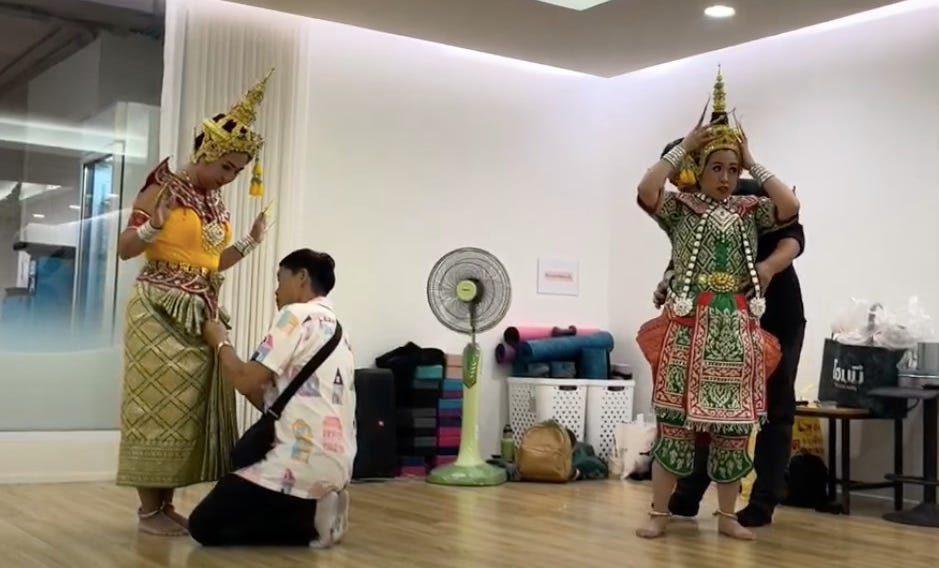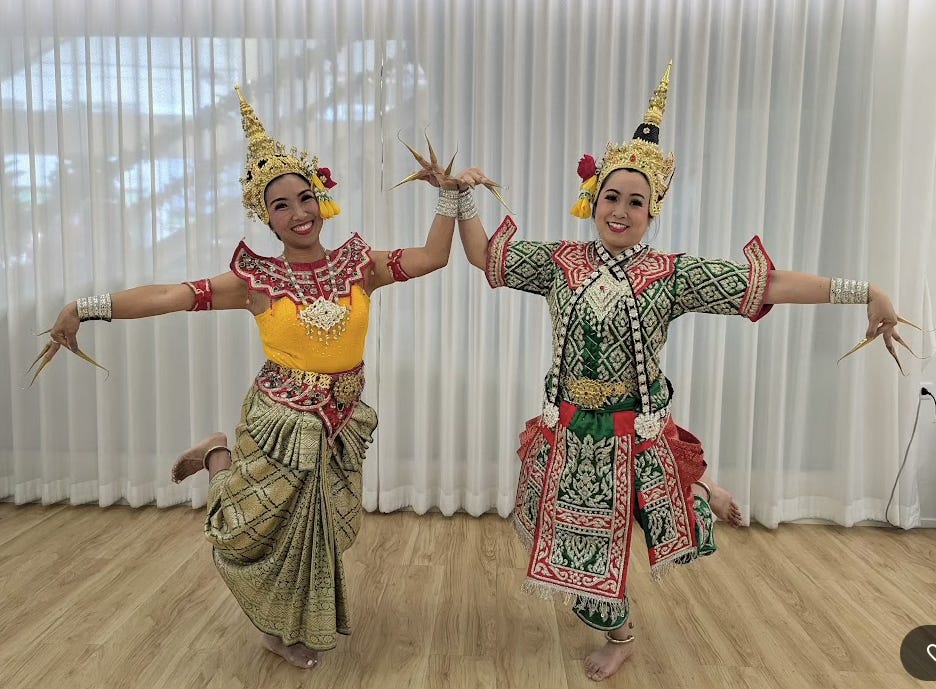Temple Arts (part two)
If there is the power to cover us up, there is also the power to reach deep inside.
Happy New Year!
I waited to send this next installment so I could include photos from the day we demo’ed Thai dance during our trip - when this next passage was also read for our travelers as we got dressed. I have since returned from Thailand to greet the Year of the Snake - and the photos have since come in. So, here they are, along with Temple Arts, part two.
Dance
I grew up as a Thai dancer at a temple. The “at a temple” matters. Otherwise, troupes like ours end up touring a circuit of weddings, street fairs, and the occasional theatrical production – wherever we get called for gigs. At a temple, it’s a different gig. Performing blessing dances year in and year out - cycling around the sun through a calendar of holidays. A holiday is not complete without all its elements. The flowers. Monks chanting. The speeches. Blessings. Ceremony. What is a special occasion without ceremony?
Back when I fielded the Thai Cultural Center’s email account, I got a message from a woman asking how she might start learning Thai dance. I explained that lessons at the Temple were “free” and that what was taught depended on the needs of upcoming performances. She answered back, “I was looking to dance as a spiritual practice, and not really interested in performing,” and the exchange ended there. At the time, I had neither heard of Thai dance as a spiritual practice, nor Thai dance without performing. I understood her reluctance because of the time and heavy lift that shows required. I cringed at the thought of dressing up and moving my hips in front of an audience. I started dancing as a teenager, and I considered performance the cost of admission for what every teenager wants: the set of friendships that came along with it.
In the years since, I thought more about the woman’s request and what dancing was for me. Without the shows, so much is lost from the whole package of dancing at a temple. The line that makes one activity a spiritual practice, and another not, is not so crisp. Some visitors come asking whether the monks offer meditation classes, and we must disappoint there as well. “It’s not that kind of temple.”
At the Berkeley Thai Temple, the performers, instruments, costumes, and masks and crowns of gods housed in one building. The monks, their robes, the Buddha shrine, candles, and incense in the next one over. The founding abbot said, “where there is a temple, there must also be a school.” We work in concert. The sacred learning that happens when a temple and school are one and the same. This pairing that was so during my mother’s childhood and as it still is in many villages, Thai or not, worldwide. Monks come to our aid as much as we do them. They order a blessing dance. We ask for blessing chants. The music, dance, and ritual that make it a holiday and not just a mass of people at a food court. People come, catching glimpses and tunes of practices distant yet desired in modern times. I am no farmer, yet I have danced the rice harvest, rain dance, silk-weaving, fabric dying, tea picking, gem mining, even poking a red ants’ nest for eggs. I have worn most styles of traditional dress and seen where they fall in the pantheon of myths, folklore, and epic battles. It’s not difficult to remember which gods were known for what after feeling their sword clash with yours.
The prep involved in looking regal was fun, but not glamorous. My peers and I arrived show days with itchy scalps, not having shampooed for days, because greasy hair was better than overusing hairspray. We wore button-down shirts because taking off a t-shirt would dishevel hair and smudge makeup. Underneath everything, we wore form-fitting tanks and shorts because costume changes are fast, and there’s no time be shy about undressing.
Thai costuming has so many elements that it takes many hands to get dressed, especially when dancers are fidgety children and spacey teenagers. We started the transformation by applying foundation and powder to our faces, then sat on the floor waiting for the next available hair and makeup station. Grabbing a box of bobby pins, I handed them one-by-one to teacher as they fixed loose strands, and then covered my face in my hands during the toxic spray to set it in place. Looking up and down, closing and opening my eyes as eyeliner and lashes went on. A pinkie gently pressed and turned my cheeks left and right to get blushed. Lipstick can wait until after we had eaten.
The day before, the costumes will have been laid out, organized, and double checked before the flurry of performers, musicians, parents, siblings, elders, teachers - all crowding in the same place to get changed. If a corset was needed, we relied on each other to safety pin it snug enough to not fall but not so tight you couldn’t breathe or move, tucking in stray bra straps. My friends and I stood there, exposed in our biker shorts and feeling the draft on our bare shoulders, waiting for the teacher or elder who knew how to put together the ensemble. “Come,” waving the next one of us over. Each piece handed to us in sequence – wraps, skirts, tops – ensuring the right color goes on the right dancer given their spot in the line up. The adornment arranged into piles. Golden belts. Jewelry. Hair pieces. Flowers. Masks. Crowns.
The task was to get kids out of their jeans, hoodies, and graphic tees and into sparkly, scratchy, sometimes heavy, traditional wear – turning us into farmers, sovereigns, deities, and warriors. The lengthy dressing and shows were not easy or convenient, yet they showed me the full spectrum of temple life. The repeated fortification of our timing, flexibility, patience – physical or otherwise. The down-to-the-wire search for missing items and people. The quick run-throughs for nervous performers. The audible gasp when the curtains open to a long lost royal court painted in gold. The surprise and delight when the quietest kid in the bunch steps out on stage and lets out their joy.
Teachers gave each dancer a once-over when complete. Some got in the zone while prepping us, an entire troupe and themselves to dress in a few short hours. The same teachers who, during rehearsals, scolded students for being late or not listening – who outright laughed at our imperfect attempts to speak Thai. While dressing us, they turned us around, looked us over, smoothed out wrinkles, admiring their handywork. They squeezed in final reminders not to forget this or that move once we got out there. “Okay,” they declared once satisfied, “beautiful.” A matter of fact. “Beautiful. Now off you go,” and moved onto the next beautiful student. Before we learned to exchange hugs and affectionate words, we had this. Their fingers on our faces, their arms reaching around our bodies, their eyes taking us in. The gestures and small touches that somehow, over time, bind us to one another beyond the confines of a show.
One could argue that what we wear does not make us who we are. True, and what we wear can also cover us up. If there is the power to cover us up, there is also the power to reach deep inside. Dressing in that way I got a taste of full glory. Not an everyday occurrence and not to be skipped or shortcut. Not to be misunderstood as vanity and chasing spotlight. It took me a long time to get this. When someone holds open a long glittering textile, wraps it around me, folds the pleats one by one, and ties it in place with rope and knots – when the teacher instructs me to give a sign of respect before donning a crown – I am awakened. The safety of t-shirts and jeans now removed, and the sacredness of what’s in their place shining light on what was hidden. Teachers and elders were unrelenting and insistent about showcasing, not only the beauty in the dance, but in everyone – everyone. The shy ones, the reluctant, the cranky, the eager, the willing. Everyone gets ready, whether they want to or not, everyone has a role, and everyone gets out there in full glory. Spiritual practice and performance. Both require years of training for a moment. Life’s unpredictability throws curve balls of varying sizes and angles, and without warning, it’s showtime.





